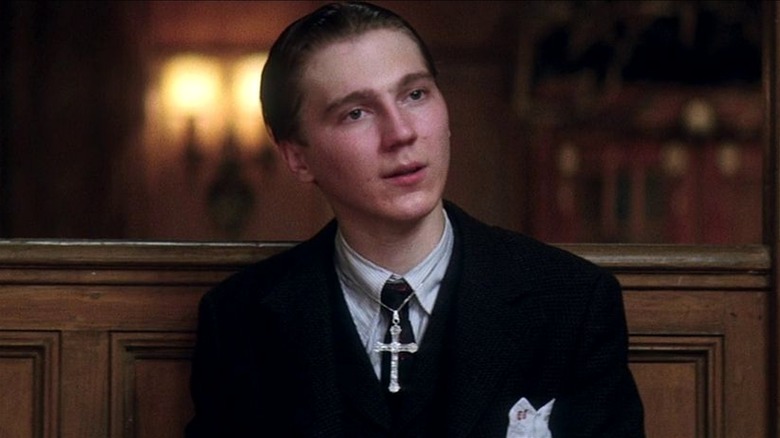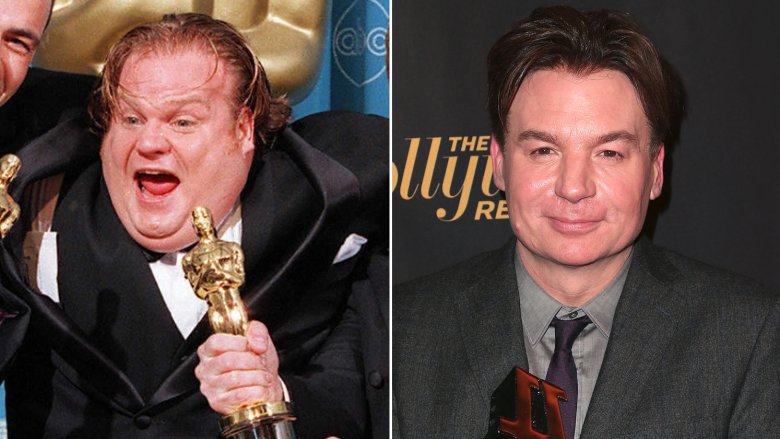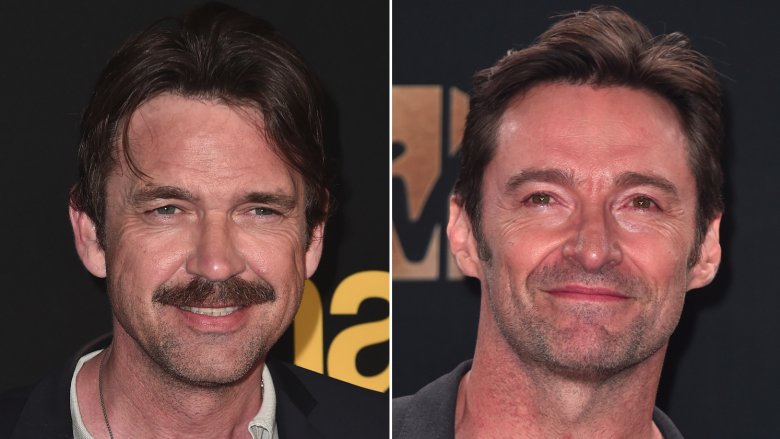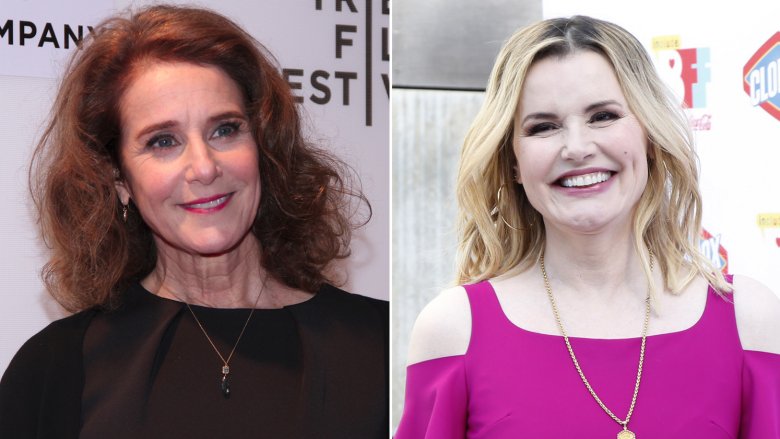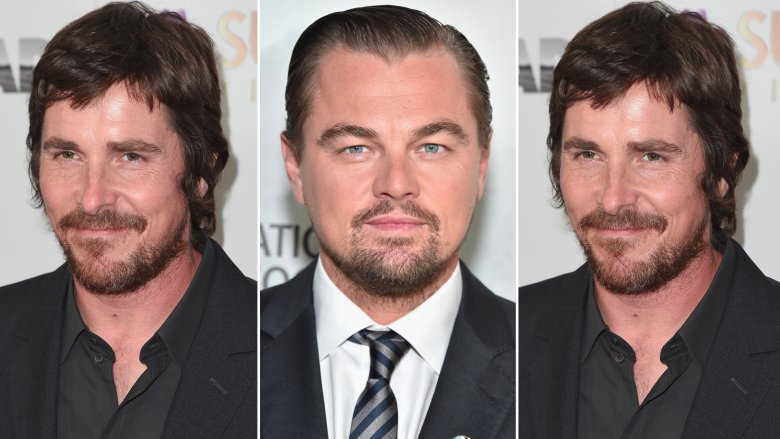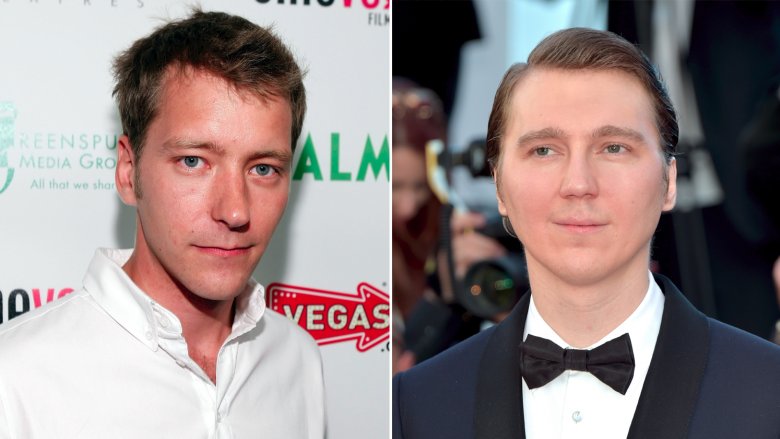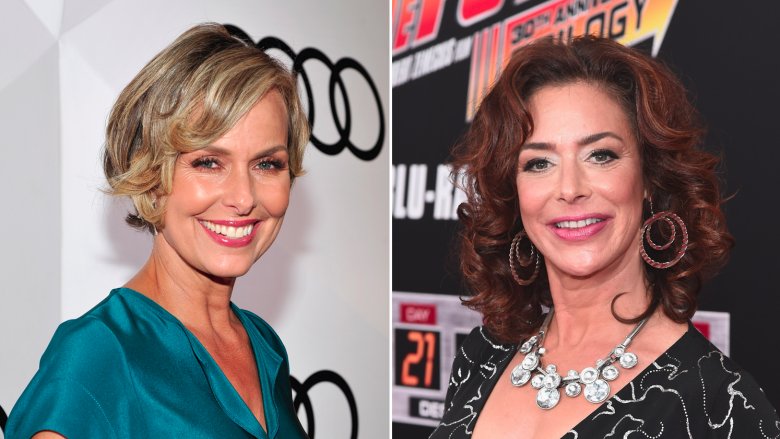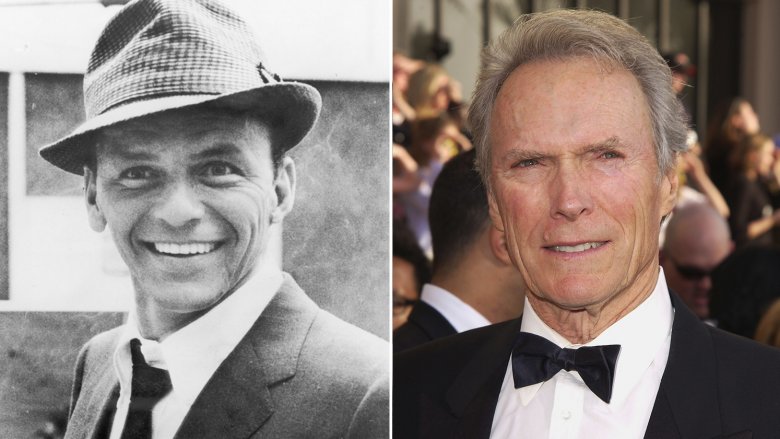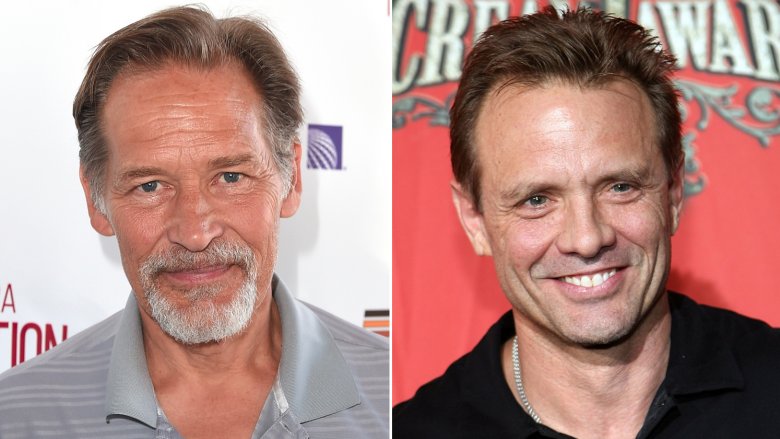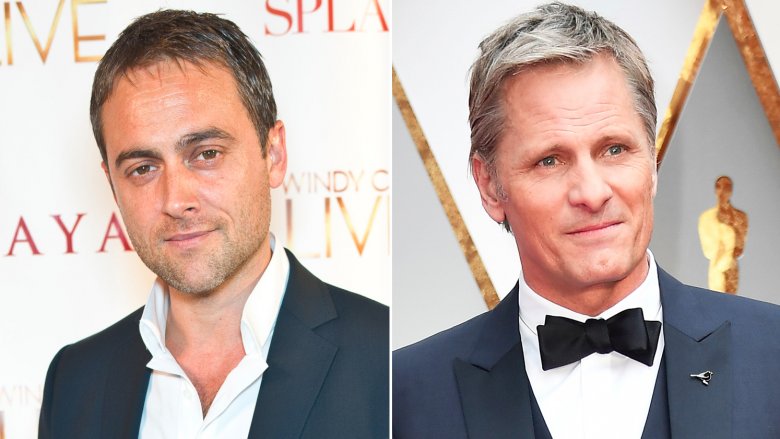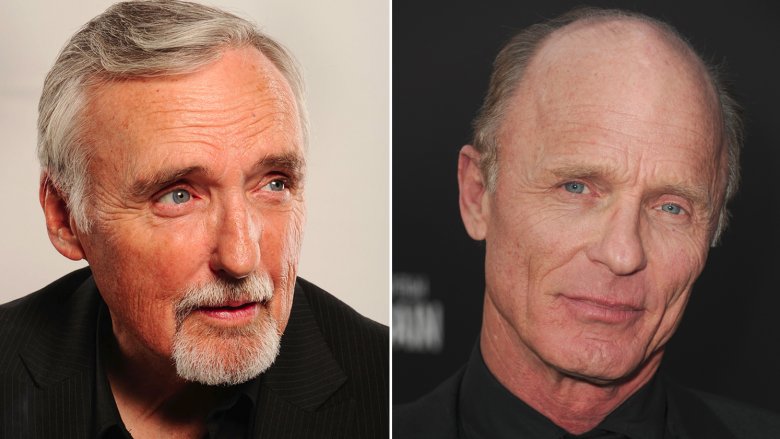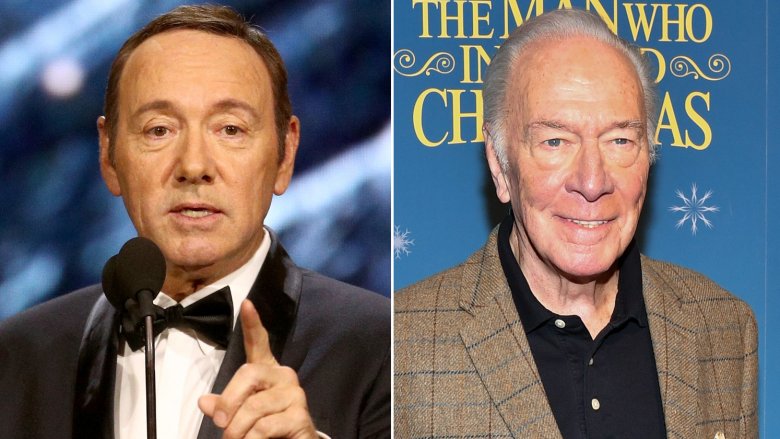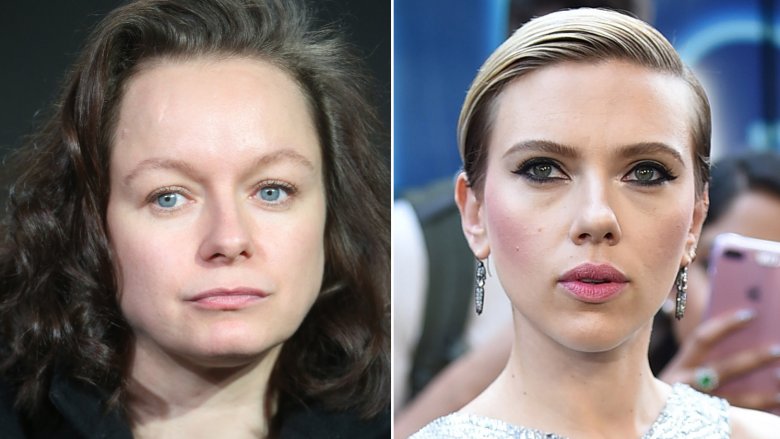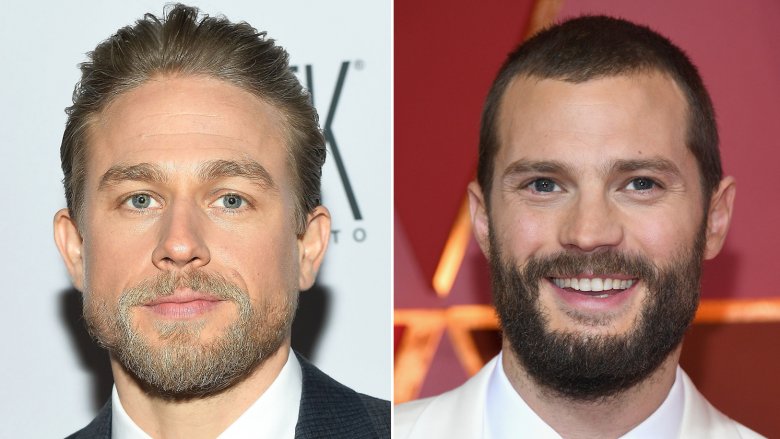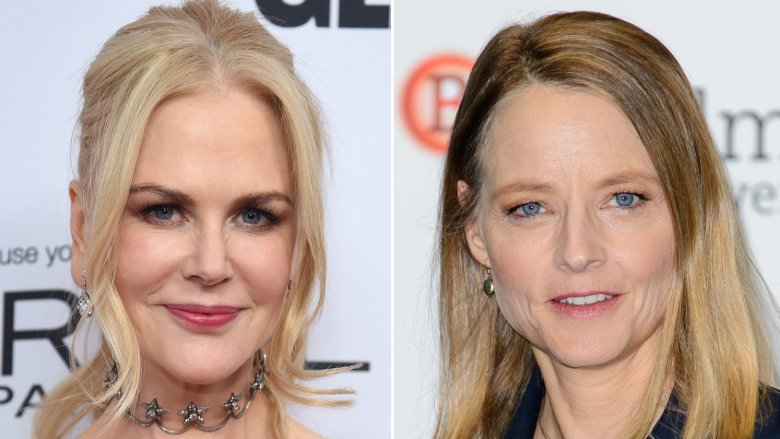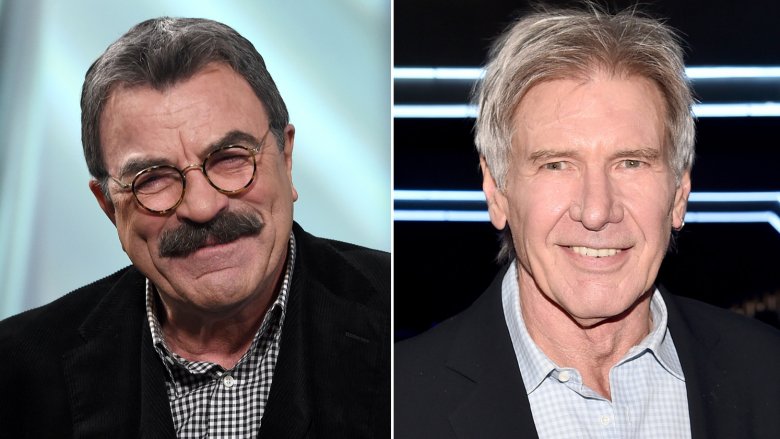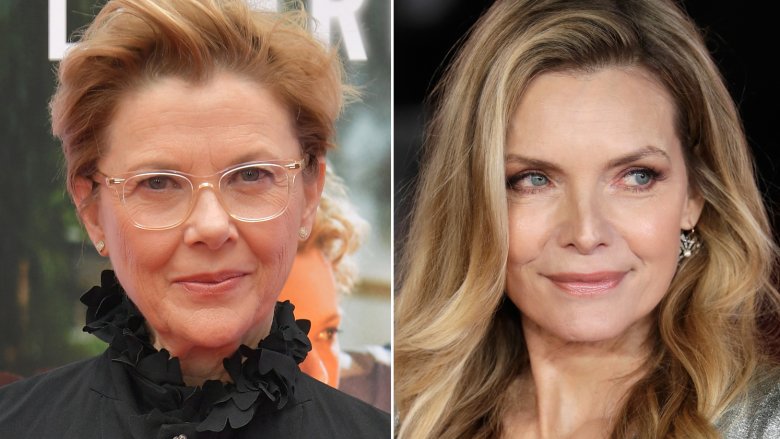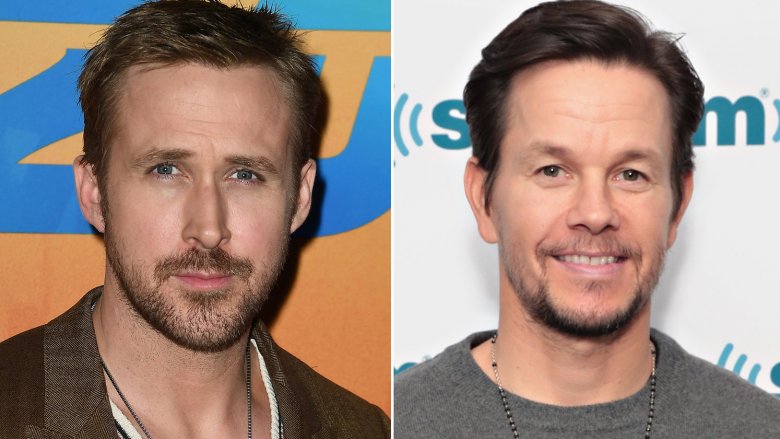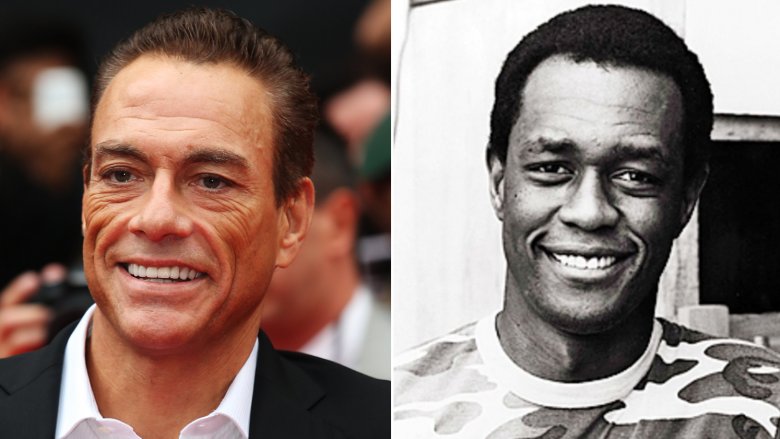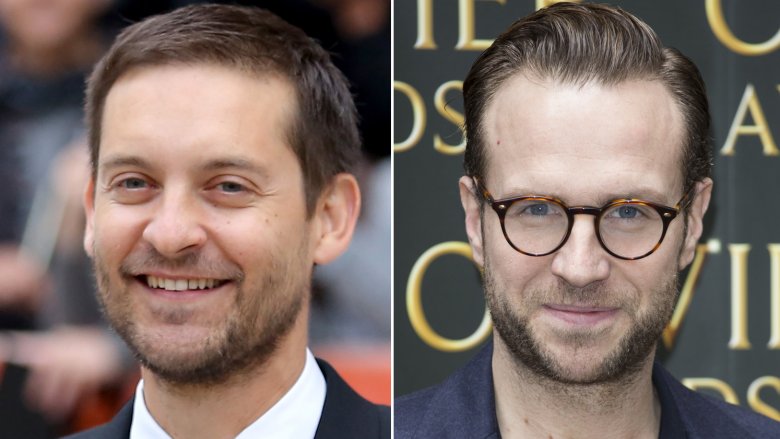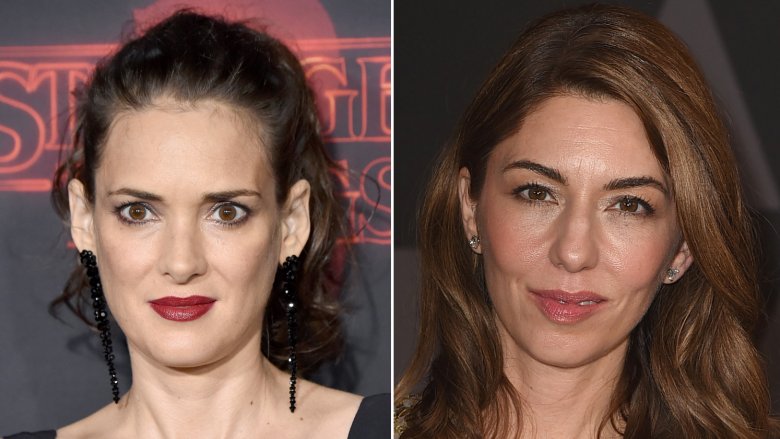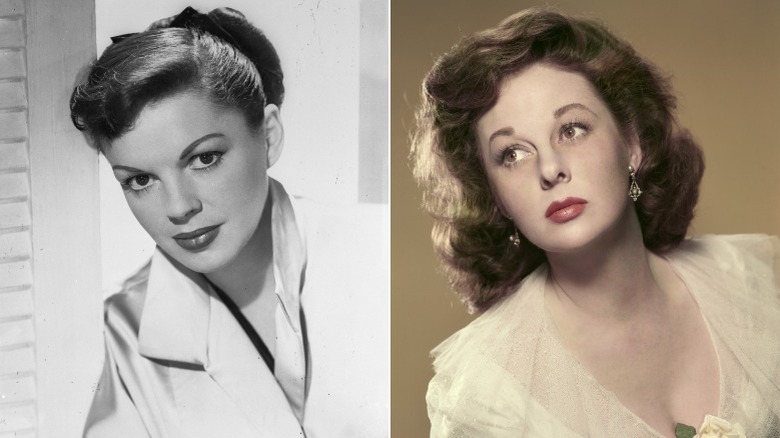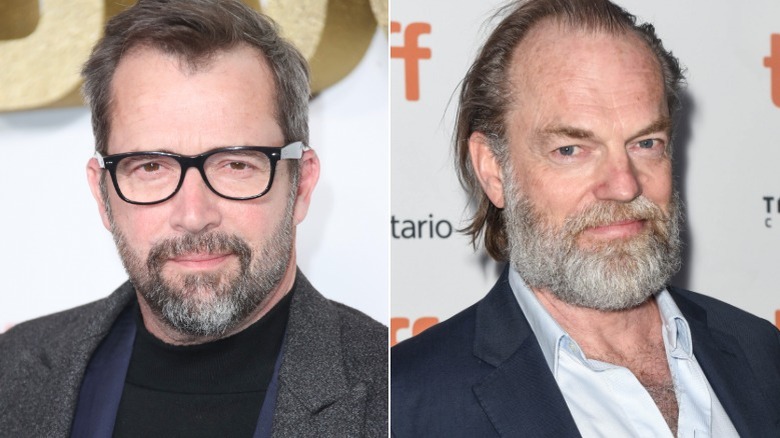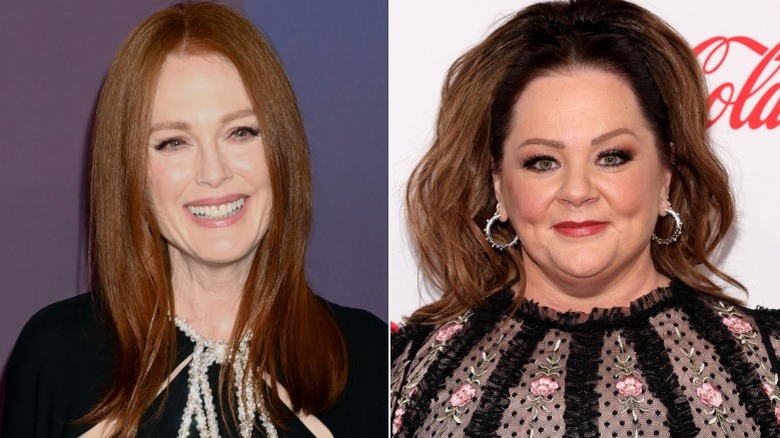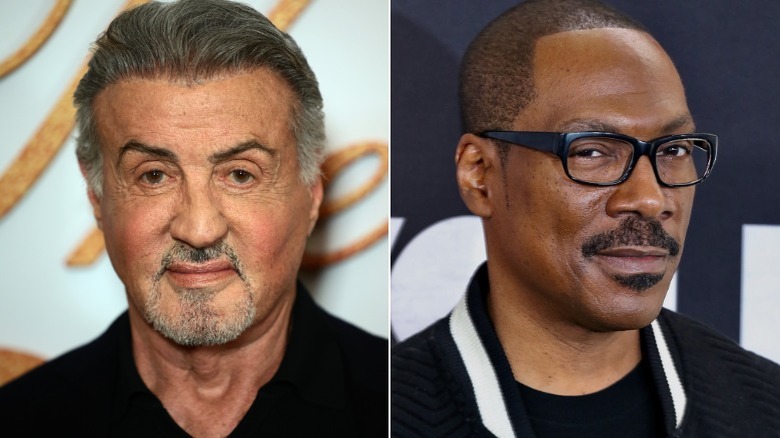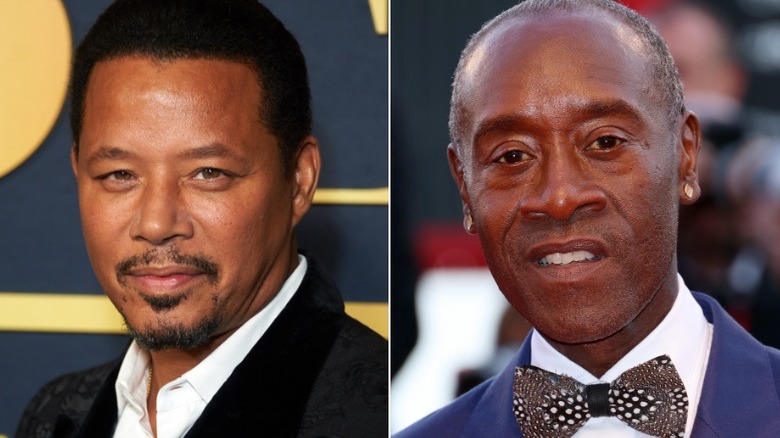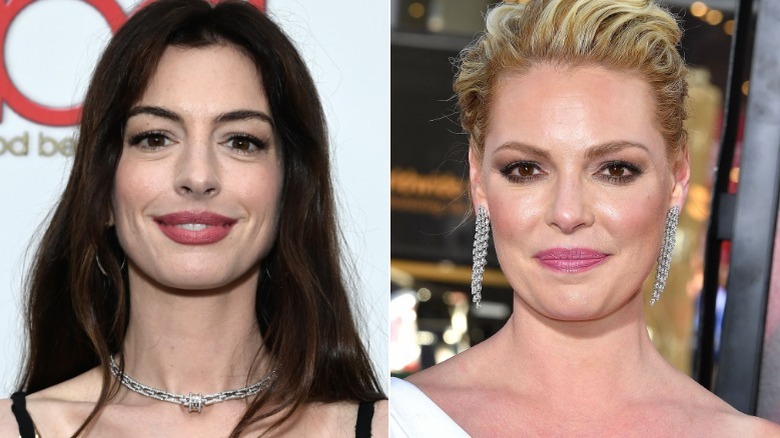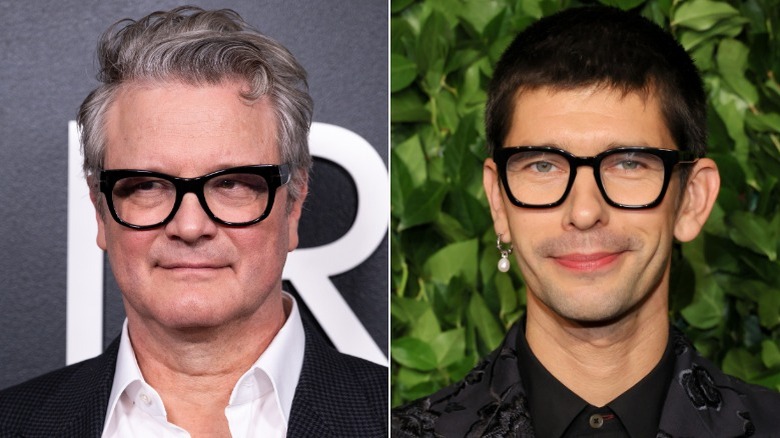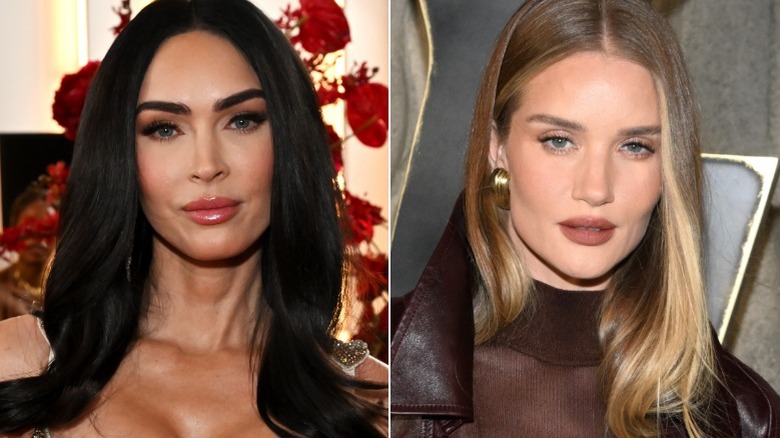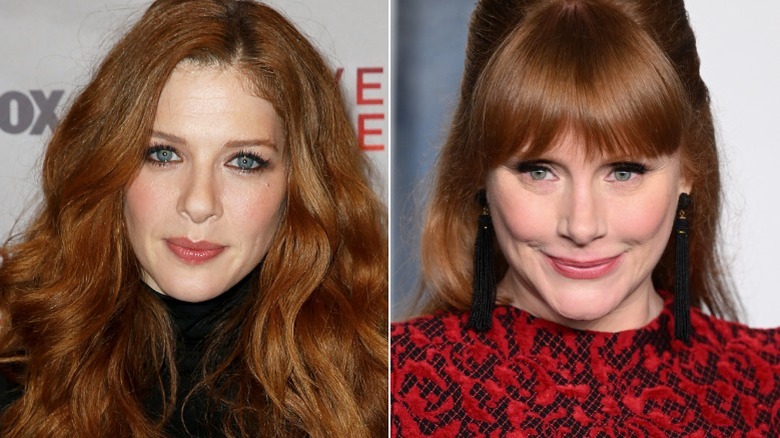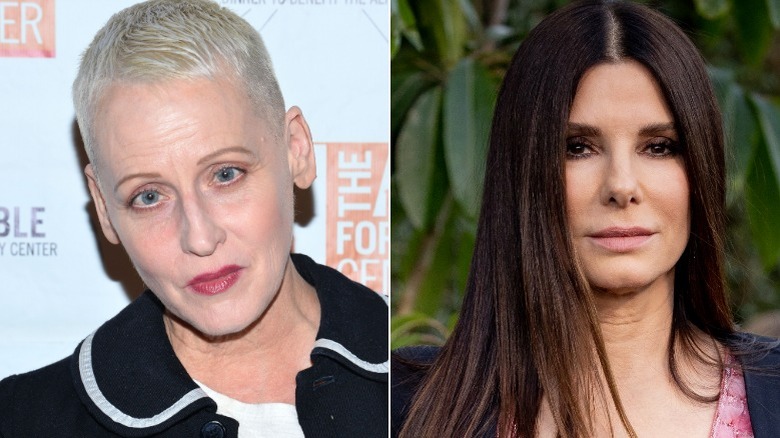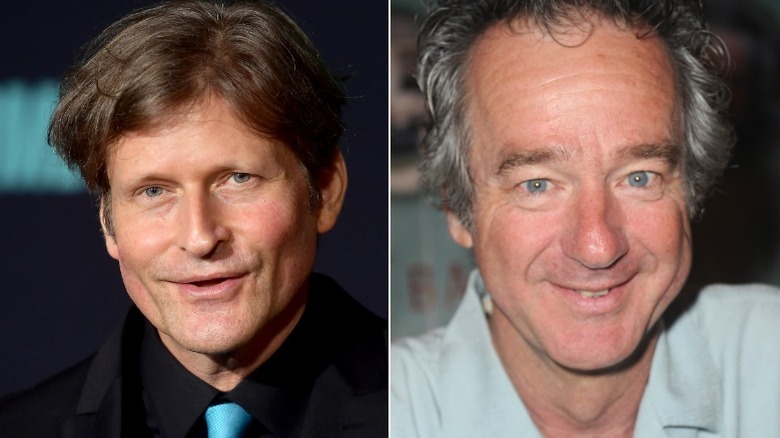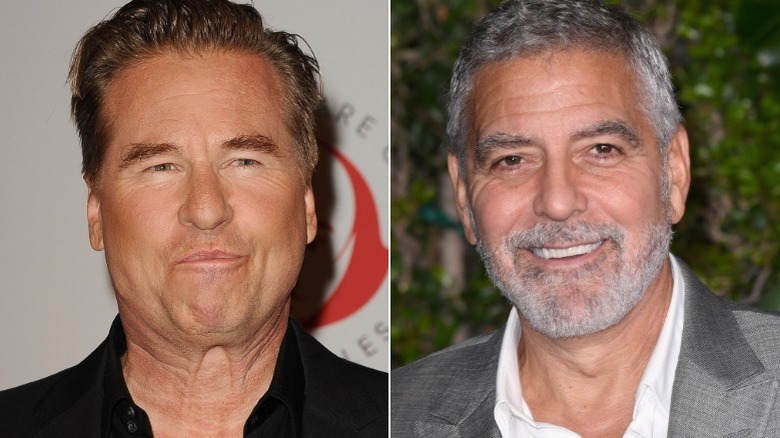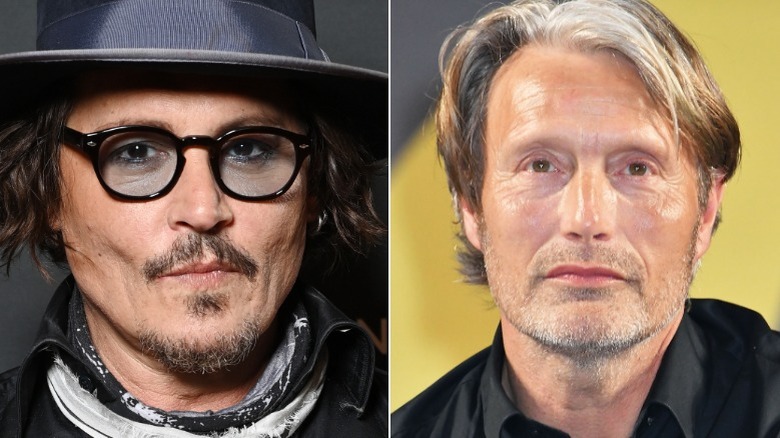Crazy Last-Minute Actor Replacements In Movies
Picking the perfect actor for a movie role is a delicate process, one that even the most-experienced casting professionals or directors can get wrong. Sometimes an actor just isn't right for the role after all, or they might have "creative differences" with the director or producers once they arrive on the set. Other times, an actor has to leave a production right before or in the middle of filming because of unforeseen circumstances or other obligations.
These issues sometimes leave producers and directors scrambling to find a replacement, and sometimes those replacements have very little time to prepare for their new part. Here are some of the craziest last-minute replacements we've seen on the big screen—many of which ended up being the replacement actor's most successful role.
Mike Myers in Shrek
After four full-length movies, countless video games, holiday specials, and other spinoffs, it's hard to imagine anything but Mike Myers' voice coming from Shrek. But the story of how Myers became the voice of the lovable green animated ogre is actually quite tragic. Originally, comedian and character actor Chris Farley had been cast in the role of Shrek, and according to his brother Kevin, Farley actually completed recording nearly all of his dialogue for the original Shrek film. Kevin also revealed that "originally the Shrek character was a little bit more like Chris, like a humble, bumbling innocent guy."
Unfortunately, Farley had been struggling for some time with alcohol and substance abuse, and it finally got the best of him. On December 18th, 1997, Farley was found dead in his Chicago apartment after an accidental drug overdose. His death left the crew at DreamWorks scrambling to find a replacement; they chose Myers, also recasting the character of Fiona (originally voiced by Farley's SNL castmate Janeane Garofalo) with Cameron Diaz. Along with the recastings came a whole host of changes to the script before Shrek's 2001 release. While there's no doubt Myers did a great job with the role, if you'd like to hear what Farley would have sounded like, check out some of the audio footage available on YouTube.
Hugh Jackman in X-Men
Hugh Jackman got extremely lucky when he landed the part of Wolverine in the 2000 comic book movie X-Men. The role (and film) would spawn a franchise worth millions of dollars, essentially setting up the then-unknown Australian actor for life, but Jackman wasn't director Bryan Singer's first choice for the role of the troubled mutant with a mysterious past. Originally, Singer wanted Russell Crowe for the part of Wolverine, but Crowe turned it down. He recommended his friend (and fellow Australian) Hugh Jackman for the part, but Singer decided to go with a more experienced actor, and cast Dougray Scott instead.
For Scott, 2000 was shaping up as a banner year. He'd been hand-picked by Tom Cruise to play the bad guy in Mission: Impossible 2, and the role of Wolverine had the potential to propel him to superstardom. Unfortunately, production on Mission: Impossible 2 was delayed, which left Scott unavailable when shooting for X-Men was getting underway. Forced to make a last-minute change in the main cast after filming had already begun, Singer called in Jackman for an audition, gave him the role, and the rest is history.
Geena Davis in A League of Their Own
Geena Davis won the hearts of moviegoers everywhere with her performance as Dottie Hinson in the 1992 sports dramedy A League of Their Own, but originally, a completely different actress was set to lead the Rockford Peaches. Debra Winger was director Penny Marshall's original choice for the role of Dottie, but she wasn't interested in blockbuster movies or entertainers with big egos, and she grew furious when she learned that Marshall had cast Madonna in a supporting role. Marshall later recalled in her memoir that Winger told her "You're making an Elvis film!" before walking off the set. Winger subsequently took a nearly decade-long hiatus from the industry after her Oscar-nominated role in the 1993 film Shadowlands.
Winger's late departure left Marshall in a tough spot, and she had to act fast to find her new Dottie Hinson. She eventually settled on Geena Davis, who auditioned in Marshall's backyard by proving that she could accurately throw a ball. While the rest of the cast had been training together for months prior to filming in order to hone their ball-playing skills, Davis had to work hard and fast to get into shape for the demanding role. She proved she was definitely up to the task—impressing her coaches and even performing that famous catch while doing a split.
Christian Bale in American Psycho
In an odd turn of events, Christian Bale ended up replacing himself for the role of Patrick Bateman in the 2000 black comedy horror film American Psycho—well, sort of. In a classic example of what happens when the producers and the director have very different visions for their movie, both Christian Bale and Leonardo DiCaprio were cast for the part of Bateman. Director Mary Harron had chosen Bale for the role, but the British actor wasn't yet the superstar he is today. The executives at Lionsgate Films wanted a high-profile actor that could deliver a box-office success with his star power alone, and made a $20 million offer to DiCaprio—without informing Harron.
DiCaprio's casting as Bateman was later announced at the 1998 Cannes Film Festival, which blindsided both Harron and Bale. Although Harron fought hard to keep Bale, Lionsgate eventually removed her from the project, too—replacing her with Oliver Stone. After Stone started revising the script, the film fell into a period of development hell, and DiCaprio eventually left to film The Beach. Following DiCaprio's departure, Stone also left, and Lionsgate execs finally came back to Harron, hats in hand. She agreed to return as director, and Bale (who had cleverly kept his own schedule clear) was cast again as Bateman. Their perseverance definitely paid off, as the film became a polarizing box office success and eventual cult classic—helping propel Bale to the top of Hollywood's A-list.
Paul Dano in There Will be Blood
The 2007 drama There Will Be Blood was widely acclaimed upon its release, and eventually went on to rack up dozens of accolades—including an Academy Award for Best Actor going to star Daniel Day-Lewis. But did you know that the other lead character—Eli Sunday (Paul Dano)—was originally played by someone else entirely? That's right, the part of Eli was first assigned to actor and director Kel O'Neill. However, after a month of shooting, director Paul Thomas Anderson decided that O'Neill just wasn't right for the part.
After O'Neill was let go, Anderson didn't have to look far to find a replacement. Paul Dano had already been cast in the film with a smaller part as Eli's brother, Paul Sunday, and had so impressed Anderson that he decided to make the Sunday brothers twins so Dano could play both parts. Dano did an impressive job with the last-minute change, taking only four days to prepare for the new role, which he subsequently knocked out of the park.
Claudia Wells in Back to the Future
While you may have known that Michael J. Fox wasn't the original actor cast as Marty McFly in 1985's comedy sci-fi classic Back to the Future, you might be unaware there was another major actor replacement in the movie. Originally, Eric Stoltz landed the role of Marty McFly after first choice Michael J. Fox was unavailable, but was famously dumped from the movie by director Robert Zemeckis after five weeks of filming. While Stoltz wasn't bad as Marty, the filmmakers thought he was a bit too serious for the role. When Michael J. Fox's Family Ties schedule eased a bit, he was cast as Marty, and a reshoot was scheduled. Unfortunately, this casting change presented a problem for actress Melora Hardin, who had been originally cast as Marty's girlfriend Jennifer.
Hardin had been a great counterpart to Stoltz during table readings, but the top dogs at the studio were concerned that she was too tall for the more diminutive Fox. As a result, they let Hardin go from the production before she had filmed a single scene, and cast Claudia Wells in her place. Later, Wells would also have to be replaced for the sequel when she was unavailable during filming, with Elisabeth Shue taking her place as Jennifer in Back to the Future Part II. While losing out on the original role of Jennifer surely stung at the time, Melora Hardin is still going strong today. You might recognize her from her role as Jan on the hit U.S. version of the TV comedy The Office, or as Tammy Cashman in Transparent.
Clint Eastwood in Dirty Harry
Along with his part in Sergio Leone's trilogy of Spaghetti Westerns as the Man with No Name, Clint Eastwood is also frequently remembered for his role as the hard-as-nails homicide cop Harry Callahan in Dirty Harry. But that movie—which spawned an entire franchise of sequels—almost went to another famous blue-eyed performer: Frank Sinatra. Originally, producers had quite a hard time trying to fill Harry Callahan's shoes; they reportedly offered the part to many of Hollywood's leading men, including Robert Mitchum, Steve McQueen, Burt Lancaster, and John Wayne.
Frank Sinatra was eventually cast as Callahan, and interestingly, the script written for him supposedly had Harry toting a 12-gauge shotgun as his signature weapon. But as the production got underway, Sinatra had to back out—a broken hand he sustained while filming a fight scene for 1962's The Manchurian Candidate left him unable to hold a gun. After ensuring the original script (and not the heavily revised Sinatra version) would be used, Eastwood agreed to play Harry—cementing his place in pop-culture history with a .44 Magnum and the oft-misquoted line, "you've got to ask yourself one question: 'Do I feel lucky?' Well, do you, punk?"
Michael Biehn in Aliens
For fans of the Alien film franchise, it's probably hard to picture anyone but Michael Biehn as Dwayne Hicks in the 1986 movie Aliens. In truth, Biehn was a last-minute replacement; originally, James Remar was supposed to play the corporal who teaches Ripley how to use a pulse rifle. However, a couple of weeks after filming started, Remar abruptly left the production. He later revealed during a Sidebar podcast interview that while he had originally cited "urgent matters at home" to explain his departure, the truth is that he was struggling with drug addiction at the time, and director James Cameron fired Remar after he was arrested for possession.
With literally no time to prepare for the physically demanding role, Michael Biehn was brought in as Remar's replacement. Even though no recognizable footage of Remar as Hicks remains in the finished film, Indiewire did manage to dig up some photos of Remar from the set before Biehn took his place.
Viggo Mortensen in The Lord of the Rings
Sit tight, and we'll tell you the tale of how the vampire Lestat almost played Aragorn in Peter Jackson's three-film adaptation of the The Lord of the Rings. When Jackson was casting for 2001's The Fellowship of the Ring, he had a difficult time finding the right actor to play the mysterious Aragorn. Reportedly, the part had been offered unsuccessfully to Daniel Day-Lewis, Nicolas Cage, and Russell Crowe, while Vin Diesel auditioned but never received an offer. Finally, Jackson turned to Irish actor Stuart Townsend, who you may remember as the modern version of vampire Lestat de Lioncourt in the 2002 film Queen of the Damned.
Townsend traveled to New Zealand with the rest of the cast and spent two months training and working alongside them, only to be fired the day before filming began. Jackson apparently decided the baby-faced Townsend was too young to convincingly play the rugged and much older Aragorn of the books. While Jackson claimed things with Townsend ended amicably, Townsend later expressed quite a bit of bitterness towards the director for firing him—and for allegedly stiffing him on his paycheck. Mortensen was subsequently offered the role of Aragorn, but only agreed after being urged to accept by his then 10-year-old son, Henry. Mortensen flew down to the set (reading the book on the plane to prepare), jumped right into filming, and the rest is cinematic history.
Ed Harris in The Truman Show
While star Jim Carrey was undoubtedly the driving force behind the success of the critically acclaimed satirical sci-fi film The Truman Show, the film (and the "Truman Show" itself) wouldn't have been possible without the efforts of the obsessive showrunner Christof, played masterfully by Ed Harris. But Harris wasn't director Peter Weir's first pick for Christof—originally, Dennis Hopper was cast in the role.
After filming began, Weir and Hopper ran into "creative differences" on the set, leading Hopper to leave the production entirely. Hopper later revealed that he was fired after only two days of filming—a decision he called "a major blow" at the time. Called up at the last minute to replace Hopper, Harris threw himself into the role with gusto—earning himself a Best Supporting Actor Oscar nomination for his efforts.
Christopher Plummer in All the Money in the World
While less common than scheduling conflicts or "creative differences," sometimes an actor is fired because of criminal accusations or bad behavior. Robert Downey Jr. was fired from Ally McBeal because of his arrests, and CNN actually keeps a running timeline of Lindsay Lohan's various legal troubles. However, these examples pale in comparison to the serious accusations facing Kevin Spacey. In the wake of sexual assault allegations made against producer Harvey Weinstein, Star Trek: Discovery actor Anthony Rapp leveled similar charges against Kevin Spacey. Rapp alleged that a drunken Spacey had once pinned him down on a bed and tried to seduce him. Spacey offered Rapp an apology, drawing ire from many for also using his response to come out as gay. Following Rapp's accusation, at least 15 others came forward with similar claims of sexual abuse—including several people involved in the production of Spacey's long-running Netflix series, House of Cards.
The backlash was immediate and intense. Netflix cut all ties with Spacey, suspending production on House of Cards and axing their release of their biopic Gore. His publicist dropped him, and the International Emmy Awards withdrew an honor that Spacey was slated to receive in 2017. Additionally, director Ridley Scott removed Spacey entirely from All the Money in the World, due in theaters December 22, 2017. Scott announced that Christopher Plummer would take Spacey's place and that he would re-shoot all of Spacey's scenes—a decision that will reportedly cost millions in production costs and rush fees.
Scarlett Johansson in Her
Most last-minute actor changes happen before filming gets fully underway, but in 2012, Scarlett Johansson was asked to replace an actor on a movie that was already in post-production. In Spike Jonze's 2013 sci-fi romance drama Her, Joaquin Phoenix plays a lonely writer who finds himself falling in love with "Samantha," an artificially-intelligent operating system. Initially, English actress Samantha Morton provided the voice of the computer program that bears her name, but Jonze decided after filming wrapped that something wasn't quite right.
Jonze said Morton had been "amazing" on the set, but he ultimately "realized that what the character/movie needed was different from what Samantha and I had created together." He recast Scarlett Johannson in the role, rerecording all of the scenes that Morton had previously done and also adding a number of new scenes that Jonze "had wanted to shoot originally but didn't."
Jamie Dornan in 50 Shades of Grey
As director Sam Taylor-Johnson was preparing to make her 2015 adaptation of author E. L. James' best-selling erotic drama, she found that casting the perfect pair of actors to be her Christian and Anastasia was not an easy task. Before eventually deciding on Dakota Johnson for the part of Anastasia Steele, Taylor-Johnson auditioned a number of other prominent actresses in the role. She even offered the part to Game of Thrones star Emilia Clarke, who turned it down due to the nudity required.
For the role of 27-year-old billionaire Christian Grey, a number of Hollywood's leading men were considered or even offered the part—including Robert Pattinson, Ryan Gosling, Garrett Hedlund, Chace Crawford, and several others. In September 2013, it was announced that Charlie Hunnam had been chosen for the part of Christian. Not all fans were thrilled with the decision—a Change.org petition calling for Matt Bomer and Alexis Bledel to be given the starring roles eventually garnered over 90,000 signatures. Less than a month before filming started, Hunnam was forced to drop out of the film because of scheduling conflicts with his popular television series Sons of Anarchy. Another lightning-fast round of auditions for the part of Grey ensued, with Jamie Dornan eventually coming out on top.
Jodie Foster in Panic Room
After achieving a major box-office success with Fight Club in 2000, director David Fincher turned to his next project, the 2002 thriller Panic Room. The movie focuses on a mother and daughter who must retreat to a safe room in their new home after it is invaded by burglars. Fincher knew that finding the right actresses to play the women would be integral to the success of his movie. Interestingly, neither of Fincher's original casting choices for these parts ever made it into the film. At first, Nicole Kidman and Hayden Panettiere had been cast as the mother and daughter, but Panettiere dropped out of the project before filming got underway. She was replaced by Kristen Stewart in what was her first starring role.
Filming for Panic Room began in January 2001, but Kidman didn't last long. Just two weeks after principal photography began, Kidman was hurt on the set, aggravating an old knee injury she sustained while filming Moulin Rouge. Kidman left Panic Room to recover, and Fincher had to scramble to find a replacement quickly. Meanwhile, actress and director Jodie Foster had to shut down production on her own movie, Flora Plum, after its star Russell Crowe was also injured. After being tapped to take on Kidman's former role in Panic Room, the irony of the situation wasn't lost on Foster. "I remember emailing Russell saying, 'I'm doing Nicole's movie—how ironic is that?"
Harrison Ford in Raiders of the Lost Ark
When director Steven Spielberg was first preparing to make Raiders of the Lost Ark, his friend George Lucas (who co-wrote the Raiders script) was adamantly against the idea of casting Harrison Ford as Indiana Jones. At that point, Ford had already starred in three of Lucas' other films—American Graffiti, Star Wars: A New Hope, and Star Wars: The Empire Strikes Back—and Lucas was worried about working too often with the same actor. Lucas told Spielberg that he didn't want Ford to "be my Bobby DeNiro"—referring to the numerous collaborations between actor Robert DeNiro and director Martin Scorsese.
Instead of Ford, Spielberg and Lucas initially cast Tom Selleck as Indy. Selleck did a screen test for the part (which you can watch on YouTube), and he later explained to David Letterman that he did not turn down the role, as some may believe. When Spielberg and Lucas offered him the part, Selleck was under contract with CBS because of the pilot he'd just completed for Magnum P.I. Spielberg and Lucas attempted to negotiate with the network to "borrow" Selleck for their movie, but CBS wouldn't budge, refusing to let Selleck do Raiders. Spielberg convinced George Lucas to give in, and Harrison Ford was cast in what would become one of his most iconic roles less than three weeks before filming began.
Michelle Pfeiffer in Batman Returns
In 1992, Michelle Pfeiffer made waves when she gave a provocative and slightly-unhinged performance as Catwoman in Batman Returns—but the part was originally meant for someone else. Director Tim Burton had cast four-time Academy Award nominee Annette Bening as Catwoman—a decision that left Pfeiffer heartbroken. "As a young girl, I was completely obsessed with Catwoman. When I heard that Tim was making the film and Catwoman had already been cast, I was devastated," she explained.
However, Pfeiffer got a chance to make her childhood dream come true when Bening became pregnant and was forced to drop out of the film. Burton recast her in the role, and Pfeiffer threw herself into kickboxing and whip training in order to give a convincing performance. Unlike Halle Berry's take on the part in 2004's Catwoman—which was unhinged in a much different way—Pfeiffer earned acclaim for the role. Even more than 25 years later, Pfeiffer's Catwoman remains one of our most favorites.
Mark Wahlberg in The Lovely Bones
When Lord of the Rings director Peter Jackson was getting ready to make the 2009 supernatural drama The Lovely Bones, he initially cast Ryan Gosling in the leading male role. Gosling was to play grieving father Jack Salmon, who becomes obsessed with finding the person responsible for his teenage daughter's murder. Shortly before filming started, Gosling unexpectedly announced his departure from the film. At the time, Gosling claimed that he left The Lovely Bones because he felt "the age of the character versus my real age" just wasn't working out. However, the truth is that Peter Jackson actually fired the La La Land star from the movie.
Apparently, Ryan Gosling showed up on the set sporting a scraggly beard and weighing some 60 pounds heavier than he'd been when he was cast—a physical transformation that the actor hadn't discussed with the director. Although Gosling was supposed to be playing a severely depressed man, Jackson fired Gosling for the unplanned weight gain—which reportedly involved Gosling drinking melted Häagen-Dazs ice cream. "We had a different idea of how the character should look," Gosling said. "I just showed up on set, and I had gotten it wrong...then I was fat and unemployed." He was replaced by Mark Wahlberg, who was given the part just one day before filming began.
Kevin Peter Hall in Predator
If we told you that Jean-Claude Van Damme had originally been part of the cast in 1987's Predator, you might imagine him playing Arnold Schwarzenegger's role as Major Alan "Dutch" Schaefer. Actually, Van Damme was supposed to play the Predator creature itself. At that time, the Predator was supposed to have a much different fighting style—one that would make use of Van Damme's martial arts skills. What's more, the original Predator costume designed for Van Damme had "backward-bent reptilian legs, extended arms and a [protruding] head."
Reportedly, Van Damme (who was not yet a star) didn't understand that he was essentially to be a stuntman for the duration of the film. He had thought that audiences would get to see his face and that he'd get to fight Schwarzenegger in some hand-to-hand combat scenes. When he found out the truth, Van Damme was "seething." In the documentary If It Bleeds We Can Kill It: The Making of 'Predator,' it was also reported that Van Damme had passed out while filming jungle scenes in the hot creature suit. Eventually, John McTiernan scrapped all of the original plans for the Predator—including Van Damme's casting. He was replaced by the seven foot two inch tall tall Kevin Peter Hall in the role, and the costume itself was redesigned into the iconic Predator that we know today.
Rafe Spall in Life of Pi
For Ang Lee's acclaimed 2012 survival drama Life of Pi, the director originally intended to use a cast comprised of unknown actors. The sole exception to this was Tobey Maguire, who Lee tapped to play Yann Martel—the Canadian author who actually wrote the novel Life of Pi that Lee's film was based upon. Maguire arrived on the set and had actually filmed all of his scenes before Lee decided that it wasn't working: the actor was too recognizable and stuck out like sore thumb among the rest of the cast. Lee cut Maguire from the movie, explaining that "to be consistent with the other casting choices made for the film, I decided to go with an entirely international cast." He re-shot all of Maguire's scenes with Prometheus star Rafe Spall, who got a chance to share in Life of Pi's glory when it received eleven Academy Award nominations and four wins.
Sofia Coppola in The Godfather Part III
If you hated The Godfather Part III, don't blame Sofia Coppola—she wasn't even supposed to be in the film. Among fans of Francis Ford Coppola's trilogy of films about the fictional Corleone crime family, Part III is usually considered the weakest entry. This is largely due to his daughter Sofia Coppola's flat performance as Michael Corleone's daughter, Mary. Finding an actress to play the central figure of Mary was one of Francis Ford Coppola's biggest problems. He had originally offered the part to Julia Roberts, but she had to drop out because of scheduling conflicts elsewhere. Madonna was eager to land the role, but Coppola felt that she was too old to play the part of the teenaged Mary. He'd scheduled an audition for Rebecca Shaeffer, but the actress was tragically murdered on her own doorstep the morning of her audition.
Coppola eventually cast the 18-year-old Winona Ryder, who was fresh off her success with Edward Scissorhands. However, Ryder was suffering from nervous exhaustion when she arrived on-set, and dropped out at the last minute. With production already running behind schedule and over budget, Francis Ford Coppola made the difficult decision to cast his own 18-year-old daughter, Sofia. The decision to cast Sofia (who had no formal acting training) drew ire from fans and charges of nepotism, and critics treated both Sofia and her father harshly in their reviews of the film. In the years since, Sofia Coppola has gone on to have a successful career as a director, but her part in The Godfather Part III remains a black mark on her Hollywood resume.
Claire Danes in Romeo + Juliet
When director Baz Luhrmann took on the artistic challenge of modernizing Shakespeare's 16th-century play "Romeo and Juliet" for the grunge-listening youth of the '90s, he understood the importance of selecting the ideal actors for the leading roles. Hot off his Oscar nomination for "What's Eating Gilbert Grape," the young and charming Leonardo DiCaprio was an obvious choice for the love-struck Romeo. His Juliet, on the other hand, was a more difficult find. Although we now know the role eventually went to "My So-Called Life" star Claire Danes, she wasn't the first or even second choice.
Originally, Luhrmann had cast then-14-year-old Natalie Portman. The age was fitting for the original character, but when a 21-year-old DiCaprio came into the picture, the problematic age gap quickly became apparent. "[20th Century] Fox said it looked like Leonardo DiCaprio was molesting me when we kissed," Portman told The New York Times in 1996. Luhrmann agreed, saying in a 2022 interview with The New York Times, "She was 14. And when you see Leo in the flesh, he's a tall, young man and you just realized, she was too young. Natalie was amazing in the footage, but it was too much of a burden for her at that age." Luhrmann went through several more months of auditions before finding Danes. Although DiCaprio still had some years on the 17-year-old actress, DiCaprio spoke glowingly of his "Romeo + Juliet" co-star, saying, "She was the only girl that looked me in the eye in auditions" (via the New Yorker). It was a match made in Verona.
Susan Hayward in Valley of the Dolls
After her breakout role as Dorothy Gale in 1939's "The Wizard of Oz," Judy Garland starred in Hollywood's biggest pictures as her career reached soaring heights. However, by the end of the 1940s, Garland's worsening mental health and dependence on various substances took a heavy toll on many aspects of her life, including her career. Time away from sets and unpredictable behavior resulted in Garland being fired on multiple occasions on films such as "The Barkleys of Broadway," "Annie Get Your Gun," and "Royal Wedding." However, after these instances, she was inevitably replaced again, but this time with much more publicity surrounding the incident.
In 1967, Garland was cast as Helen Lawson in "Valley of the Dolls," an ironically fitting story about women's struggles with the destructive facets of fame. She got as far as wardrobe tests and recording the movie's original song "I'll Plant My Own Tree" before being fired a week into filming for being under the influence. However, Garland's brief co-star Patty Duke had a different recollection of events, claiming in her 1987 autobiography "Call Me Anna" that the studio and director exploited Garland's condition for publicity. Susan Hayward replaced Garland, and just two years later, the queen of musicals died at the age of 47 from an accidental barbiturate overdose. One can only imagine how "Valley of the Dolls" would have been received if it had been Garland's final performance.
Hugo Weaving in V for Vendetta
Before Hugo Weaving donned the Guy Fawkes mask as the freedom-fighting leader against the oppressive rule of the Norsefire political party, there was another actor in line for the role. James Purefoy of "Rome" fame was the original anarchist behind the mask before leaving six weeks into filming. Why? Director James McTeigue claimed in a 2006 Syfy interview that Purefoy felt too uncomfortable acting behind the restrictive mask. Fair enough. McTeigue himself recognizes the difficulties posed by the addition of the mask — especially when finding a suitable actor to wear it. When speaking to CBR during the movie's filming, McTeigue said, "It's hard putting anyone in a mask. It's a difficult thing to do, but I think it can also be liberating, too. It hasn't been done in a big film really where you don't see the person underneath the mask. It was a challenge and still is."
However, it couldn't have been easy for first-time director McTeigue to find a replacement for the lead on such short notice so far into filming. Luckily, Weaving was willing and available. To save as much time as possible, Weaving also dubbed over Purefoy's already filmed scenes. What we ended up with was a politically polarizing cult favorite, and we wouldn't want it any other way.
Melissa McCarthy in Can You Ever Forgive Me?
Developing a movie from an idea to a final product often takes years, and the 2018 biographical drama "Can You Ever Forgive Me?" was no expectation, with a complicated 11-year journey. The process of getting financing for the production was a long one, but when "Friends With Money" director Nicole Holofcener signed on along with "The Hours" star Julianne Moore, everything started coming together — until it all went wrong. A week before filming began, Variety reported that Moore withdrew from the project due to creative differences. Shortly after, Holofcener also departed, but not before recasting the part of Lee Israel with Melissa McCarthy.
However, Moore has since come out with a different version of events, telling Andy Cohen on an episode of "Watch What Happens Live With Andy Cohen," "I didn't leave that movie, I was fired. Nicole fired me. So yeah, that's the truth." Moore went on to praise McCarthy, proving no ill will between the two. Holofcener was also pleased with her replacement, "The Diary of a Teenage Girl" director Marielle Heller. Heller continued with Holofcener's screenplay, and McCarthy delivered an Oscar-nominated performance that transformed her career from comedy queen to serious, dramatic actor.
Eddie Murphy in Beverly Hills Cop
Before Eddie Murphy became one of the biggest actors in Hollywood, he was known for his larger-than-life characters on "Saturday Night Live." All that changed when "Beverly Hills Cop" launched him into movie stardom. Much of the movie we know today can be attributed to Murphy's comedic chops, but believe it or not, it was almost Sylvester Stallone rather than Murphy who played the role of quick-witted Detroit cop Axel Foley. Two weeks before filming commenced, Stallone left the project, unsatisfied with the movie's comedic tones.
Although we'll never know for sure how "Beverly Hills Cop" would've turned out with Stallone as the lead, we can make some pretty solid guesses based on the numerous story rewrites. Before turning the role down altogether, Stallone did some rewrites of his own to better suit his set of acting skills. According to Stallone, his rewrites were reminiscent of the opening scene from "Saving Private Ryan." "Needless to say, they dropkicked me and my script out of the office, and the rest is history," he recalled in a 2006 interview with Ain't It Cool News. If, after reading that, you feel like you missed out on an incredible movie, you can rest assured knowing Stallone's ideas were reworked into his 1986 movie "Cobra."
Don Cheadle in Iron Man 2
Between launching the Marvel Cinematic Universe and marking Robert Downey Jr.'s triumphant return to the spotlight, we owe a lot to 2008's "Iron Man." However, it's safe to assume Terrence Howard doesn't share that sentiment. After being the first and highest-paid actor signed onto the project for the role of James "Rhodey" Rhodes, Howard ended up getting the boot from the following sequels. There have been a few reasons reported for this: A disappointing performance and unprofessional behavior are most often cited.
Rather than outright terminating Howard's contract, Marvel Studios proposed a significantly reduced payment for his role in the sequel, believing the movie would be successful with or without him. Unable to come to an agreement, the two parted ways. The studio wasted no time and began pursuing Don Cheadle as Howard's replacement. According to Howard, Cheadle was initially the studio's preferred choice for the role despite ultimately choosing Howard, so in a way, it was a full-circle moment for almost everyone involved.
Katherine Heigl in Knocked Up
Building off the success of his feature directorial debut "The 40-Year-Old Virgin," Judd Apatow directed "Knocked Up," a raunchy romantic comedy about an unplanned pregnancy after a one-night stand between two clashing personalities. Casting the male lead was no problem — Apatow had worked with actor Seth Rogen on many occasions in the past, and the two became close friends in the process. There was no one better for the job. "Obviously, I can't stress how important Judd's been to my career," Rogen told The Telegraph.
However, in Apatow's boys-only comedy circle, finding the right actor for the female lead wasn't as easy. "The Devil Wears Prada" star Anne Hathaway ended up taking on the role before dropping out due to the nature of the movie's birth scene. "Hathaway dropped out of the film because she didn't want to allow us to use real footage of a woman giving birth to create the illusion that she is giving birth," Apatow told The New York Times. Hathway clarified with Allure, saying, "My issue with it was that having not experienced motherhood myself, I didn't know how I was gonna feel on the other side about giving birth." Things eventually fell into place when Katherine Heigl, known for her role in "Grey's Anatomy," stepped in to replace Hathaway. There was no denying the natural on-screen chemistry she shared with co-star Rogen or Heigl's ability to hold her own in the male-centric flick.
Ben Whishaw in Paddington
In 2013, it was announced that the beloved children's literature anthropomorphic bear, Paddington, was getting his very own CGI/live-action film. Colin Firth, who director Paul King described to Entertainment Weekly as having "the most beautiful voice on the planet," was originally tapped to bring the famous bear to life. "What we liked about Colin is that he's got a bearish voice, he's got a sense of humor, and he presents the very best of British," producer David Heyman explained. Except when principal photography wrapped and the film went into post-production, that opinion changed.
As the CGI animators finalized Paddington's look, there was a disconnect between the bear's youthful appearance and Firth's dramatic, older voice. "Colin was the first to say, 'I just don't know that I have this within me,' and we slowly, sadly agreed," said King. And with that, Firth voluntarily withdrew from the project and was replaced by Ben Whishaw just a few months before the movie's theatrical release.
Rosie Huntington-Whiteley in Transformers: Dark of the Moon
Considering the prior success of the first two movies in the "Transformers" franchise, director Michael Bay didn't take Megan Fox's firing from the third installment, "Transformers: Dark of the Moon," lightly. Luckily for Bay, the main character's love interest isn't what drives ticket sales in an action movie about automobile robots. With a simple off-screen breakup, Fox was replaced by a new girlfriend, played by Rosie Huntington-Whiteley.
Why exactly was Fox cut? In a 2009 interview with Wonderland, Fox made some comments about Bay's onset behavior, comparing him to a certain fascist dictator. "He's like Napoleon and he wants to create this insane, infamous madman reputation. He wants to be like Hitler on his sets, and he is," Fox remarked. This hyperbole didn't go unpunished. In addition to having qualms with her work ethic, Bay claimed in an interview with GQ that executive producer Steven Spielberg demanded her firing. "I wasn't hurt, because I know that's just Megan. Megan loves to get a response. And she does it in kind of the wrong way. I'm sorry, Megan. I'm sorry I made you work twelve hours. I'm sorry that I'm making you show up on time. Movies are not always warm and fuzzy," Bay responded. Although Fox was out of a job, surely she was relieved to be parting ways with a boss she deemed unpleasant. Meanwhile, "Transformers: Dark of the Moon" grossed more than $1 billion at the box office.
Bryce Dallas Howard in The Twilight Saga: Eclipse
"The Twilight Saga" will always be remembered for popularizing the trend of supernatural romances in the late 2000s and early 2010s. Little girls everywhere dreamed of finding their own sparkly vampire to sweep them off their feet and save them from the dangers of bloodthirsty nomadic vampires. In "Twilight" and "New Moon," the first two installments of the series, Rachelle Lefevre portrayed the thirstiest of them all: the vengeful vampire Victoria. Her firey red hair and ruthless desire for Bella's blood made her the perfect villain and a fan favorite. So when news broke that Victoria was being recast, it came as a surprise to everyone — including Lefevre.
"I was stunned by Summit's decision to recast the role of Victoria for 'Eclipse,'" Lefevre told Access Hollywood. "I turned down several other film opportunities and, in accordance with my contractual rights, accepted only roles that would involve very short shooting schedules." One of those roles was for a project called "Barney's Version," which overlapped ten days with "Eclipse's" three-month shooting schedule. Summit responded by claiming Lefevre withheld from disclosing this scheduling conflict for more than a month. Feeling as though Lefevre's actions were uncooperative and put the production at risk, Bryce Dallas Howard was cast to take her place. Really, Lefevre didn't lose out on too much, since her character's death at the end of the movie would've made it her last appearance anyway.
Sandra Bullock in Demolition Man
In the sci-fi action movie "Demolition Man," Stallone and Wesley Snipes go head-to-head in an effects-driven, explosion-heavy game of cops and robbers in the year 2032, after both were cryogenically frozen in 1996 for separate crimes. In this future, Sandra Bullock plays Stallone's colleague and love interest, but in an alternate reality, it was Lori Petty who was destined to play the futuristic cop. Sometimes, even casting directors have trouble predicting the future. After a few days of shooting, Petty was out, and Bullock was in.
Originally, the reasoning behind her departure was cited as every movie producer's go-to when there's a falling out: creative differences. Petty, on the other hand, believed it had to do with her and Stallone's lack of compatibility, comparing the two's chemistry to oil and water. Bullock lucked out as Petty's replacement. Not only was it her first big-budget feature, but it also led to her next breakout role in the action movie "Speed." Who knows what direction Bullock's career would've taken if not for this casting mishap?
Jeffrey Weissman in Back to the Future II & III
During the making of the "Back to the Future" trilogy, Robert Zemeckis and Bob Gale had no problem replacing actors when needed. They did it with Eric Stoltz, Melora Hardin, and again with Claudia Wells, but there was one replacement that maybe wasn't so obvious. On the set of "Back to the Future," tensions were high between George McFly actor Crispin Glover and the creators. Glover has stated that he was unhappy with the movie's ending, and when he raised questions about it, he was met with hostility. "The reality was that they did not want me back in the film," Glover told AV Club. Glover was offered less than half of what his co-stars were making, and when he tried to renegotiate, they reduced the offer by $25,000.
Glover walked away and was replaced by Jeffrey Weissman, who wore prosthetics to resemble Glover. Because of the prosthetics, footage from the first movie, and deliberate techniques to obscure Weissman, many never realized it wasn't Glover on screen for "Back to the Future II & III." Glover took legal action to protect his likeness. The lawsuit was settled out of court, and the Screen Actors Guild later added a clause regarding the illicit use of actors.
George Clooney in Batman & Robin
The success of Tim Burton's "Batman" helped establish Hollywood's longtime fascination with turning comic book superheroes into on-screen franchises. After grossing more than $400 million at the box office, Burton returned with "Batman Returns" in 1992 to mixed reviews. Wanting to take a less morbid approach to the character, Warner Bros. went in a new direction with Joel Schumacher as director and Val Kilmer as Batman in 1995's "Batman Forever."
When it was time for the fourth installment, "Batman & Robin," Kilmer didn't stick around. "He sort of quit, we sort of fired him," Schumacher told Entertainment Weekly. "It probably depends on who's telling the story." Schumacher went on to claim that the two never really got along, calling Kilmer "childish and impossible." From Kilmer's perspective, he felt overshadowed by the scale of the character and the franchise. "That's why it's so easy to have five or six Batmans. It's not about Batman. There is no Batman," Kilmer said in a New York Times interview. When George Clooney took over as the Caped Crusader, he had an even tougher time filling the superhero's shoes, nearly ruining his career in the process.
Mads Mikkelsen in Fantastic Beasts: The Secrets of Dumbledore
When domestic abuse allegations came out against Johnny Depp, Warner Bros. was forced to act by asking Depp to resign from "Fantastic Beasts: The Secrets of Dumbledore" as Gellert Grindelwald. The studio had to move fast to find a replacement and gave Mads Mikkelsen two days to decide if he could fill the role. "I wanted Mads to explore a version of Grindelwald that suited his strengths as an actor — and that inevitably meant a departure from what Johnny brought to the role," director David Yates told The Hollywood Reporter.
Just a couple of months after the movie's release, a jury sided with Depp in his highly publicized defamation lawsuit against his ex-wife Amber Heard. Mikkelsen gave Depp fans hope when he made a comment to Deadline. "Obviously, well, now the course has changed — he won the suit, the court [case] — so let's see if he comes back. He might. I'm a big fan of Johnny. I think he's an amazing actor, I think he did a fantastic job," he said. However, any potential sequels have reportedly been stalled until further notice.
